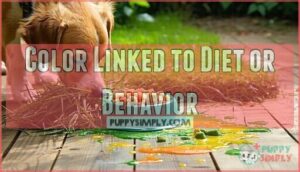This site is supported by our readers. We may earn a commission, at no cost to you, if you purchase through links.

Yellow bile, blood-tinged material, and foamy white puddles each point to different underlying causes, and knowing what you’re looking at can help you decide whether to grab paper towels or your car keys. Some colors signal minor issues that resolve on their own, while others demand immediate medical attention.
Table Of Contents
- Key Takeaways
- What Causes Dogs to Vomit?
- Dog Vomit Color Guide Explained
- What Different Vomit Colors Mean
- Vomit Consistency and Texture Clues
- Vomiting Vs. Regurgitation in Dogs
- Emergency Vomit Signs to Watch For
- When to See The Vet for Vomiting
- Preventing and Managing Vomiting in Dogs
- Frequently Asked Questions (FAQs)
- What color of throw up is bad for dogs?
- What color is pancreatitis dog vomit?
- What color is dog vomit with intestinal blockage?
- What are the concerning colors of vomit?
- What is the best way to prevent dog vomiting?
- How can I make my dog more comfortable if they are vomiting?
- Is it necessary to take a sample of my dog’s vomit for testing?
- Are there any home remedies I can use to treat dog vomiting?
- Why does my dog vomit after drinking water?
- Is seasonal vomiting normal in dogs?
- Conclusion
Key Takeaways
- Vomit color serves as a diagnostic tool where yellow or orange signals bile from an empty stomach, green indicates grass consumption, white foam suggests acid buildup, brown points to partially digested food, and red or black demands immediate veterinary attention for internal bleeding.
- Bright red blood or black "coffee grounds" vomit constitutes a veterinary emergency with survival rates above 80% when treated promptly, as these colors indicate active gastrointestinal bleeding from ulcers, toxins, or internal injuries.
- Vomiting differs from regurgitation in that vomiting involves active abdominal heaving with digested material and bile, while regurgitation is passive expulsion of undigested food from the esophagus without reaching the stomach.
- Prevention strategies include gradual food transitions over seven to ten days, securing toxic substances and household hazards, tracking vomiting patterns to identify food allergens or environmental triggers, and maintaining supervised play to avoid ingestion of harmful materials.
What Causes Dogs to Vomit?
Vomiting happens for lots of reasons, and understanding what’s behind it helps you know whether it’s a minor hiccup or something more serious.
Your dog’s stomach might react to something they ate, an infection working its way through their system, or even a hidden health issue that’s just showing up now.
Let’s look at the most common triggers that send dogs running for the nearest patch of grass.
Dietary Indiscretions and Food Sensitivities
Dogs have a knack for sniffing out trouble—and eating it, which explains why dietary indiscretions top the list of vomiting triggers in our four-legged friends. Whether they’ve raided the trash, gobbled spoiled leftovers, or scarfed down something inedible, their stomachs often rebel.
Food allergies and dog food sensitivities add another layer, causing gastrointestinal issues that disrupt dog digestive health. An elimination diet can help pinpoint triggers and restore balance to your pup’s system.
Infections, Parasites, and Illness
Beyond what your dog eats, infections and parasites can also turn their stomach upside down—and these culprits often require a closer look to identify.
Common triggers include:
- Bacterial or viral infections that attack the gastrointestinal tract
- Intestinal parasites like roundworms or hookworms
- Systemic illness affecting multiple organs
- Chronic disease needing ongoing disease management
Proper infection control, parasite prevention, and veterinary care help catch these dog health issues early—your vet’s illness diagnosis tools make all the difference.
Toxins and Poisonous Substances
When your dog gets into something they shouldn’t—whether it’s household cleaners under the sink, chocolate on the counter, or toxic plants in the yard—vomiting often becomes the body’s first line of defense.
Common household hazards include antifreeze, medications, pesticides, and toxic substances from your Toxic Plant List like lilies or sago palms.
Chemical exposure triggers animal poisoning symptoms fast—if you suspect poisonous substances were ingested, contact Poison Control immediately to minimize environmental toxins damage.
Underlying Medical Conditions
Sometimes vomiting isn’t about what your dog ate today—it’s a red flag that something deeper is going wrong inside their body. Chronic diseases like liver disease or kidney disease can trigger persistent gastrointestinal issues.
Organ failure, inflammatory conditions, and immune disorders all manifest through dog vomiting causes you can’t ignore. Internal bleeding signals life-threatening emergencies requiring immediate veterinary intervention.
Dog Vomit Color Guide Explained
When your dog vomits, the color can tell you a lot about what’s happening inside. Each shade points to different causes, from an empty stomach to something more serious.
Here’s what to look for and what each color means.
Yellow and Orange Vomit (Bile)
If your dog’s vomit looks like a splash of sunshine—bright yellow or orange—you’re likely seeing bile, the digestive fluid that sits in an empty stomach and can make a dramatic appearance when things go wrong. This yellow vomit usually signals gastric issues related to bile production and digestive enzymes from liver function and pancreatic health.
Common causes include:
- Empty stomach syndrome – vomiting on an empty stomach, especially in the morning
- Bilious vomiting syndrome – bile irritation from prolonged fasting between meals
- Rapid eating or dietary changes – overwhelming the digestive system
- Gastrointestinal issues – inflammation or motility problems affecting digestion
- Underlying conditions – pancreatitis or liver dysfunction disrupting normal bile flow
Your dog vomit color guide starts here: yellow doesn’t always mean emergency, but watch the pattern.
Green Vomit (Grass or Plant Matter)
That emerald-green puddle on your floor usually tells a straightforward story—your dog’s been munching on grass, leaves, or other plant matter that didn’t quite agree with their system.
Most of the time, grass consumption is harmless—dogs eat it to settle their stomachs or out of boredom.
But green vomit warrants a closer look at what they’re eating outdoors, since plant toxicity can turn a benign habit into a health crisis requiring immediate dietary adjustments and vomit analysis.
White or Foamy Vomit
When your dog brings up frothy, white foam, you’re usually looking at an empty stomach churning out saliva, mucus, and gastric juices with nowhere to go. This foamy vomit often happens first thing in the morning or between meals when hunger meets acid buildup.
While white vomit treatment might just mean adjusting meal timing, repeated foamy stomach issues can signal canine gastroenteritis or other digestive problems—so watch the vomit foam texture and frequency closely.
Brown Vomit
Brown vomit tells a story of partially digested food making its way back up—think kibble that’s been sitting in stomach acid long enough to take on that muddy, coffee-with-cream appearance.
While brown vomit causes often trace back to simple digestive issues or your dog eating too fast, repeated episodes can point to food allergies, stomach problems, or deeper gut health concerns that deserve a closer look at your dog’s overall vomiting pattern.
Red or Bloody Vomit
Bright red blood in your dog’s vomit is a red flag—literally—signaling active gastrointestinal bleeding that demands emergency intervention. Bloody vomit causes range from foreign object ingestion (up to 25% of GI emergencies) to stomach ulcers, rodenticide poisoning, or hemorrhagic gastroenteritis, which hospitalizes nearly 78% of affected dogs.
Fresh blood suggests upper digestive trauma, while streaks may indicate minor irritation—but canine hemorrhage always warrants immediate veterinary care. It’s vital to recognize veterinary emergency signs to ensure prompt treatment.
Black or “Coffee Grounds” Vomit
Coffee-ground vomit in your dog signals partially digested blood from gastrointestinal bleeding—a veterinary emergency linked to upper GI issues in 80% of cases. This canine hematemesis appearance means stomach acid has altered the blood, pointing to serious internal injury assessment needs.
Dog health symptoms accompanying black vomit demand urgent vomit color analysis. Common causes include:
- Stomach ulcers (55% of cases)
- Toxin ingestion like rodenticides (10-15%)
- Tumors in the digestive tract (15%)
- Parasitic infections causing bleeding (7%)
- Blood clotting disorders (8-12%)
Understanding dog vomiting causes is vital for identifying the underlying issue. Don’t wait—this dog vomit color guide confirms immediate vet care improves survival beyond 80%.
What Different Vomit Colors Mean
Now that you’ve seen what color your dog’s vomit is, it’s time to understand what that color actually means.
The shade you’re looking at can point to everything from a simple dietary choice to a serious medical emergency. Let’s break down what each color is trying to tell you about your dog’s health.
When Color Signals an Emergency
Some vomit colors act like canine alerts—they’re your dog’s way of signaling a medical emergency that can’t wait. Bright red vomit means fresh bleeding in the gastrointestinal tract, while black or "coffee grounds" appearance indicates partially digested blood from internal sources like ulcers.
These emergency vomit color codes demand immediate veterinary care, as roughly 60–80% of cases with bloody vomit involve confirmed gastric or esophageal damage. Watch for toxic symptoms too—pale gums, weakness, or collapse alongside abnormal vomit signals life-threatening complications requiring urgent intervention.
Color Linked to Diet or Behavior
Not all alarming colors mean danger—sometimes your dog’s vomit simply reflects what they’ve been snacking on or their recent behavior around the house. Green vomit often traces back to grass nibbling, while orange hues might follow a carrot-heavy meal.
Dietary influences and eating habits—like gulping food too fast—frequently explain unusual colors in your dog vomit color guide. Food allergies can trigger yellow bile, especially when nutrient deficiencies or behavioral factors drive pica (eating non-food items), linking canine health issues directly to vomiting causes.
Color Indicating Digestive Issues
When vomit color shifts beyond what your dog ate, it often points to something going on inside their digestive system that needs your attention. Here’s what different shades signal about gut health and stomach problems:
- Persistent yellow bile suggests an empty stomach or gastritis affecting digestive health
- Brown with a foul odor may indicate slower gut motility or gastrointestinal problems
- Foamy white vomit often signals acid buildup from prolonged stomach emptiness
- Mucous-coated material points to irritation along your dog’s digestive tract
This dog vomit color guide helps you spot gut issues early through careful vomit analysis and color codes interpretation.
Color Suggesting Toxin Exposure
If you spot unusual colors that don’t match anything your dog recently ate—especially paired with strange behavior or rapid-onset symptoms—toxin exposure might be the hidden culprit behind the vomiting. Bright, unnatural shades combined with drooling, tremors, or disorientation are Toxin Alert Signs demanding emergency responses.
Poisonous substances create varying toxicity levels and exposure risks, so knowing your dog vomit color patterns helps you recognize animal poisoning early and protect your pet’s health when seconds count.
Vomit Consistency and Texture Clues
Color tells you part of the story, but texture and consistency can reveal just as much about what’s going on inside your dog’s system. Whether the vomit is chunky or watery, foamy or thick, and how often it happens all offer important clues.
Here’s what to look for when evaluating your dog’s vomit beyond just the color.
Chunky Vs. Liquid Vomit
The texture of what your dog brings up can tell you whether it’s freshly eaten food making a quick exit or something that’s been sitting in the stomach for a while.
Chunky dog vomit usually contains recognizable food pieces, suggesting rapid digestion speed or dietary indiscretion. Liquid dog vomit, often mixed with bile, indicates an empty stomach or prolonged gut health issues.
If your dog’s vomiting symptoms include frequent episodes of either texture, that’s your cue to assess their stomach contents and overall condition more carefully.
Foamy and Mucousy Vomit
Foamy or mucousy vomit often shows up when your dog’s stomach is mostly empty and their digestive tract is working overtime to protect itself. You’ll notice this foamy vomit texture when mucous production ramps up to shield the stomach lining from acid.
It’s a common sign of gastro issues like gastritis or acid reflux. While occasional episodes happen, repeated foamy dog vomit points to digestive health concerns that need attention for your canine health.
Frequency and Amount Patterns
Pay attention to how often your dog vomits—it tells you a lot about what’s going on. Nearly half of all dog vomiting cases involve just one episode lasting less than a day, but when frequency climbs, so does concern.
Dogs presenting with multiple episodes generally hit a median of five vomiting incidents, though some reach 28. Duration correlations matter too: vomiting every 2–6 hours for 1–3 days signals your dog needs veterinary attention, especially when frequency pairs with other symptoms like diarrhea or lethargy.
Vomiting Vs. Regurgitation in Dogs
Vomiting and regurgitation might look similar at first glance, but they’re actually two different processes with distinct causes.
Knowing how to tell them apart can help you figure out whether your dog needs immediate veterinary attention or just a bit of monitoring.
Let’s break down the key differences, what triggers regurgitation, and how you can recognize which one you’re dealing with.
Key Differences and Symptoms
You might think vomiting and regurgitation are two words for the same messy problem, but your dog’s body sees them as completely different events. Vomiting involves active abdominal heaving and produces digested material mixed with bile, while regurgitation is passive—your dog simply brings up undigested food without effort or warning.
Recognizing these symptom variations helps you describe what’s happening to your vet, which guides their diagnostic approaches and medical interventions for your dog’s canine health concerns.
| Feature | Vomiting | Regurgitation |
|---|---|---|
| Effort | Active retching, abdominal contractions | Passive, easy expulsion |
| Material | Partially digested food, bile, stomach fluid | Undigested food, often tubular shape |
| Warning Signs | Nausea, drooling, lip-licking beforehand | Sudden, no warning symptoms |
| Appearance | Yellow bile present, digested consistency | Recognizable food pieces, no bile |
| Origin | Stomach and upper intestine | Esophagus, never reaches stomach |
Causes of Regurgitation
Regurgitation doesn’t stem from stomach trouble—it’s an esophageal problem that blocks food before it ever reaches your dog’s digestive system. Structural abnormalities like megaesophagus, strictures, or foreign objects trapped in the throat prevent normal swallowing. Sometimes rapid eating triggers regurgitation, but persistent episodes warrant investigation to rule out serious digestive health conditions.
| Cause Type | Common Examples | What Happens |
|---|---|---|
| Structural Issues | Megaesophagus, esophageal stricture | Esophagus can’t move food properly to stomach |
| Obstructions | Bones, toys, string lodged in throat | Physical blockage prevents swallowing |
| Eating Behaviors | Gulping food too quickly, overeating | Food overwhelms esophagus capacity |
| Congenital Problems | Vascular ring anomalies in puppies | Birth defects compress esophagus |
| Inflammation | Esophagitis from acid reflux or irritation | Swollen esophageal tissue blocks passage |
How to Tell Them Apart
Telling vomiting and regurgitation apart comes down to watching the timing, effort, and appearance of what comes back up. Vomiting involves active heaving and abdominal contractions, while regurgitation happens passively, almost effortlessly. Check your dog vomit color—digested material suggests vomiting, whereas undigested food points to regurgitation.
| Vomiting | Regurgitation |
|---|---|
| Active retching and stomach contractions | Passive expulsion with no effort |
| Partially digested food with bile (yellow/green) | Undigested food, tubular shape |
| Minutes to hours after eating | Immediately or shortly after eating |
| Often preceded by nausea signs (drooling, pacing) | No warning signs or distress |
Emergency Vomit Signs to Watch For
Not all vomiting episodes require a trip to the vet, but some warning signs demand immediate attention. Certain colors, patterns, and symptoms can signal a serious medical emergency that shouldn’t wait.
Here’s what to watch for and when you need to act fast.
Blood or Black “Coffee Grounds” Vomit
When your dog vomits blood or something resembling coffee grounds, this signals gastrointestinal bleeding—a veterinary emergency demanding immediate attention. Black vomit causes usually involve stomach ulcers, toxins like rodenticides, or internal injuries. This canine hemorrhage occurs when blood mixes with stomach acid, creating that distinctive dark appearance.
Here’s what makes coffee ground vomit so serious:
- Nearly 95% of hospitalized dogs survive with prompt emergency vet care
- Mortality rates climb without immediate veterinary care for dogs experiencing active bleeding
- Associated symptoms include lethargy, pale gums, and weakness
- Blood in dog vomit indicates active internal bleeding requiring urgent diagnosis
Don’t wait—get to the vet immediately if you spot these vomiting patterns.
Persistent or Frequent Vomiting
Even one more round of vomiting than usual should catch your attention. When your dog throws up repeatedly over several hours or can’t keep anything down, you’re looking at a pattern that points to something more serious than a simple upset stomach. Persistent vomiting often signals canine gastroenteritis or stomach inflammation, and these gastrointestinal problems in dogs can quickly lead to dehydration and chronic illness if left unchecked.
| Vomit Patterns | What It Suggests |
|---|---|
| 3+ episodes in 2 hours | Acute stomach inflammation or vomiting triggers |
| Can’t hold water down | Severe gastroenteritis requiring IV fluids |
| Daily vomiting for 3+ days | Chronic illness or underlying condition |
| Vomiting after every meal | Obstruction or motility disorder |
| Projectile vomiting | Serious blockage or toxin exposure |
Watch your dog’s behavior closely. If they’re still active and drinking, you have a bit more time, but persistent vomiting paired with lethargy means it’s time to call your vet.
Vomit After Toxin Ingestion
If you know your dog got into something toxic—whether it’s chocolate, antifreeze, rat poison, or even certain household cleaners—vomiting afterward isn’t just a warning sign, it’s a medical emergency that demands immediate action. Time matters with toxin exposure, and waiting to see if things improve can put your dog’s life at risk.
What to do right away:
- Call Poison Control immediately—the ASPCA hotline (888-426-4435) provides expert guidance on ingestion symptoms and emergency care protocols
- Don’t try home remedies—inducing vomiting without veterinary instruction can worsen animal poisoning in certain cases
- Head to the vet for toxicology tests—bloodwork and diagnostic testing identify the specific toxins and guide treatment for your dog’s health and wellness
Vomit Accompanied by Weakness
When vomiting comes paired with weakness—whether it’s stumbling, collapse, or a dog who can’t even lift their head—you’re looking at a situation that can’t wait until morning.
Dog fatigue combined with vomiting symptoms often signals canine dehydration, shock, or internal bleeding. These weakness signs demand immediate veterinary care.
Your vet will run vomit diagnosis tests to identify vomit triggers and stabilize your dog’s health and wellness before things spiral.
When to See The Vet for Vomiting
Sometimes vomiting needs more than a wait-and-see approach. Certain situations require professional evaluation, especially when symptoms suggest something serious is happening.
Here’s when it’s time to call your vet or head to the clinic.
Vomiting With Lethargy or Collapse
Lethargy paired with vomiting isn’t just a bad day for your dog—it’s a red flag that something more serious might be shutting down their system. Canine weakness or collapse causes appear alongside vomit triggers, and you’re looking at potential organ failure, severe infection, or toxin exposure.
These emergency situations for dogs demand immediate care—don’t wait to see if your dog bounces back. Call your vet or head to emergency care right away, because dog health and wellness can deteriorate fast.
Vomit With Other Illness Symptoms
Diarrhea, fever, drooling, or a swollen belly alongside vomiting tells you the problem runs deeper than a simple upset stomach. These symptom clusters signal your dog’s body is fighting something bigger—infection, organ disease, or even toxin exposure.
Watch for:
- Abdominal pain (hunched posture, whining when touched)
- Prolonged nausea (excessive lip-licking, gulping)
- Unusual vomit patterns (increasing frequency or strange colors)
These dog illness symptoms warrant medical tests to pinpoint what’s causing your dog’s distress and catch serious dog health concerns early.
Persistent Vomiting Despite Home Care
Fasting your dog for 12 to 24 hours and offering bland food should settle most mild stomach upsets—but sometimes the vomiting just won’t quit. When home care doesn’t stop persistent vomiting within 24 hours, it’s time for vet consultations and medical tests to rule out chronic conditions or serious digestive issues.
| Home Care Failed | Action Needed |
|---|---|
| Vomiting continues past 24 hours | Schedule vet visit for diagnostic workup |
| No improvement with bland diet | Investigate underlying dog health concerns |
| Multiple episodes daily | Explore treatment options and recovery plans |
What to Expect at The Vet
Walking into the vet clinic, you’ll first answer questions about your dog’s vomiting history—frequency, color, and any recent diet changes or toxin exposure. Your vet will then perform a physical exam, checking for abdominal pain or dehydration. Here’s what usually follows:
- Diagnostic Tests: Blood work, urinalysis, and imaging (X-rays or ultrasound) help identify infections, obstructions, or organ issues—over 60% of complicated cases show blood chemistry abnormalities.
- Emergency Care: If your dog shows severe symptoms, IV fluids and antiemetic medications start immediately to stabilize hydration and stop vomiting.
- Vet Communication: Bring vomit samples or photos when possible—over 80% of first-time visits benefit from this documentation for accurate diagnosis.
Most dogs recover with supportive treatment, though follow-up in 4–5 days ensures everything’s resolved.
Preventing and Managing Vomiting in Dogs
You can take real steps to reduce vomiting episodes and keep your dog comfortable at home.
Prevention starts with smart choices about diet, environment, and routine care. Here’s what works best to protect your dog and manage occasional upset.
Safe Diet and Food Transitions
What your dog eats—and how you introduce new foods—can make all the difference between a settled stomach and a messy cleanup. Gradual dog food transitions over seven to ten days help prevent digestive issues and food sensitivities. Mix increasing amounts of the new diet with the old, watching for signs of trouble.
A balanced dog diet with proper nutrient balance maintains digestive health, whether you’re feeding kibble or exploring fresh food diet benefits.
Environmental Safety and Supervision
Your home is basically a treasure hunt for trouble—at least from your dog’s perspective. Pet proofing protects curious noses from toxins that trigger vomiting and worse. Supervised play and safe storage make all the difference.
- Lock up toxic waste like cleaning products, medications, and antifreeze in cabinets your dog can’t reach
- Scan yard hazards including poisonous plants, pesticides, and fertilizers before outdoor time
- Store food securely in containers dogs can’t nose open—especially chocolate, grapes, and onions
- Monitor chew toys for broken pieces that could cause blockages or animal poisoning
Identifying and Avoiding Triggers
Once you’ve secured the environment, tracking patterns becomes your most powerful prevention tool—knowing what sets off your dog’s stomach helps you stop problems before they start. Keep a simple log noting when vomiting happens and what your dog ate beforehand.
Food allergens like beef or chicken often reveal themselves through repeated episodes, while dietary triggers might include table scraps or sudden diet changes.
Watch for environmental hazards during walks and note any dog vomit colors that signal gastro health concerns—these prevention strategies protect your dog’s digestive issues long-term.
Home Care Tips and Remedies
After spotting patterns and dodging triggers, you’ll want a few simple tricks up your sleeve for those inevitable off days when your dog’s stomach acts up despite your best efforts.
Start with canine hydration—offer small sips of water every hour to prevent dehydration without overwhelming the gut.
Natural remedies like plain canned pumpkin can help settle a dog’s tummy, while herbal supplements such as slippery elm may soothe irritation, though you should check with your vet first.
Frequently Asked Questions (FAQs)
What color of throw up is bad for dogs?
Bright red or bloody vomit demands immediate attention—it signals internal bleeding or trauma. Black "coffee grounds" vomit is equally alarming, pointing to digested blood from the stomach.
These vomit color codes aren’t just pet care alerts; they’re urgent dog health signs requiring veterinary advice now.
What color is pancreatitis dog vomit?
Pancreatitis in dogs often causes yellow or foamy vomit due to bile, though vomiting alone doesn’t diagnose the condition.
Watch for other pancreatitis symptoms like diarrhea, abdominal pain, and lethargy alongside vomiting episodes.
What color is dog vomit with intestinal blockage?
An ounce of prevention beats a pound of cure. Intestinal blockages often produce yellow or orange vomit from bile buildup, though you might see brown material as your dog’s stomach tries to expel partially digested food that can’t move through the blocked intestine.
What are the concerning colors of vomit?
Red, black, and bloody vomit demand immediate vet attention—they signal internal bleeding or serious gastro issues. Persistent vomiting with weakness or after toxin exposure also requires emergency care.
What is the best way to prevent dog vomiting?
Prevention starts with smart feeding habits—introduce new foods gradually and stick to high-quality, digestible meals.
Supervise playtime to keep non-food items out of your dog’s mouth, store household toxins securely, and maintain a clean living space with fresh water daily.
Regular vet check-ups catch problems early.
How can I make my dog more comfortable if they are vomiting?
When your dog’s stomach is in turmoil, think of their space as a quiet sanctuary.
Withhold food for twelve to twenty-four hours, offer small sips of water, and keep them in a calm, comfortable area while monitoring their condition closely before contacting your vet.
Is it necessary to take a sample of my dog’s vomit for testing?
It’s not always necessary, but a sample can be helpful for diagnostic purposes. If your vet requests one, snap a clear photo or collect a small amount in a sealed container.
Store it in the refrigerator until your appointment—lab analysis can reveal infections, parasites, or toxins that aren’t visible to the naked eye.
Are there any home remedies I can use to treat dog vomiting?
While some mild home care tips can help—like brief fasting followed by bland foods—it’s vital to check with your vet first.
Herbal treatments and natural approaches sound tempting, but settling a dog’s tummy safely requires professional guidance, especially since vomiting can signal serious issues.
Why does my dog vomit after drinking water?
Sometimes gulping water too quickly overwhelms your dog’s stomach, triggering vomiting—especially if they’re dehydrated or anxious.
Drinking habits matter: rapid ingestion irritates the digestive system and signals stomach sensitivity.
If vomiting persists, canine hydration issues or underlying dog gastrointestinal health concerns may need attention.
Is seasonal vomiting normal in dogs?
Seasonal allergies can trigger occasional vomiting in dogs, but persistent patterns warrant attention. While environmental shifts may upset your dog’s gut health temporarily, regular seasonal vomiting isn’t normal and could signal underlying issues requiring dietary adjustments or veterinary evaluation.
Conclusion
An ounce of prevention beats a pound of cure, but when vomit happens, color tells the story. Your dog vomit color guide isn’t just about cleanup—it’s about reading the signals your dog’s body sends before a small issue becomes serious.
Yellow bile, bloody streaks, or coffee-ground texture each demand different responses, and now you know which ones warrant immediate action. Trust your instincts, watch for patterns, and remember: you’re the expert on your dog’s normal. When something feels wrong, it probably is.
- https://blog.justfoodfordogs.com/dog-vomit-color-guide.html
- https://www.purina.com/articles/dog/health/digestion/types-of-dog-vomit
- https://www.chewy.com/education/dog/health-and-wellness/dog-dark-brown-vomit
- https://gsvs.org/blog/dog-vomiting-immediate-care/
- https://www.thefarmersdog.com/digest/wikipup-decoding-dog-vomit/
















